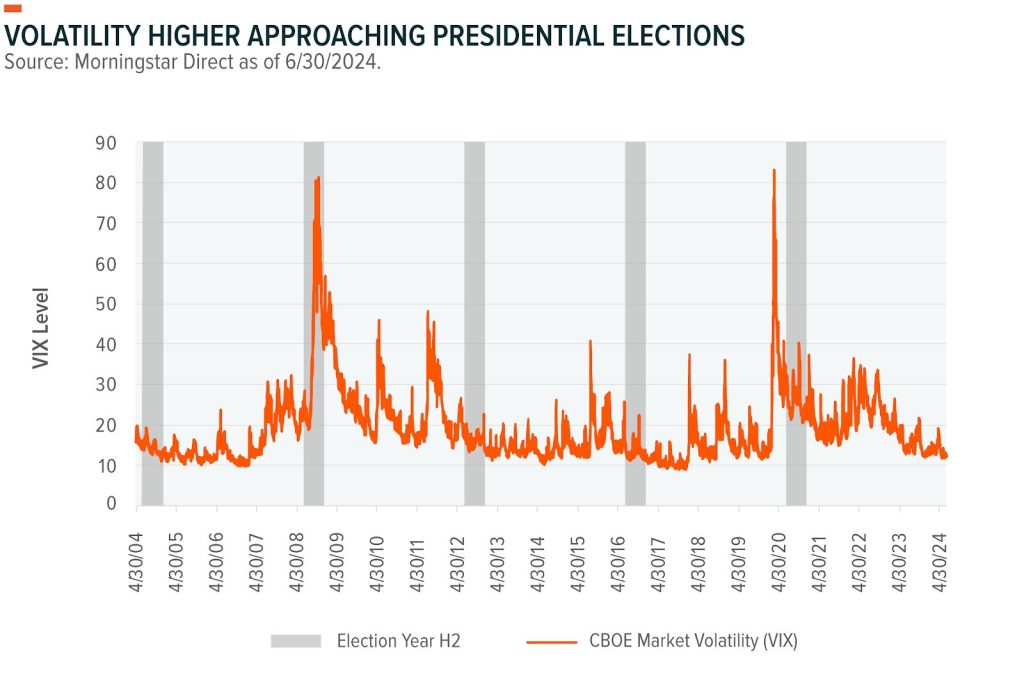By: Scott Helfstein
For a brief second, it seemed like I might get away without writing an election piece this cycle. That was wishful thinking. In my annual risks piece from December, #4 was Neither Trump Nor Biden. The market consideration at the time was more about the potential for either one to be replaced at the top of their party’s ticket, and the process whereby that might happen. The implications of President Biden’s decision to drop his reelection bid are now playing out in real time. The assassination attempt against former President Trump is an entirely different story still to unfold.
Much can happen between now and the election, and geopolitical events that shake investor confidence could bring the recent market advance to a premature end. Ultimately, I expect still-strong corporate fundamentals and reasonably healthy economic growth to carry the day.1 Whether it’s a Democrat or a Republican in the White House, neither party is making fiscal conservatism or the budget a high priority at this point.2 Different candidates could change party platforms, but that is not a base case. Consumption, investment, and government spending drive economic growth. If all three continue to advance, then the market rally can continue.3
Key Takeaways
- Separating signals from noise in the current geopolitical environment is probably harder than ever, but there may not be great information value for investors anyway.
- Market volatility traditionally rises in election years, but returns in the six months before and after presidential elections are typically good.
- Consider themes that may be insulated from geopolitical-driven volatility like U.S. Infrastructure, Defense Tech, and Uranium. Also consider traditionally less volatile assets like preferreds, covered calls, or emerging market debt less correlated with U.S. election risks.
Different Parties and Different Trajectories
President Biden faced mounting pressure to drop out of the race amid questions about his fitness. The Democrats’ big concern was that “Never Trumpers” might not turn out for President Biden, who seemed unlikely to motivate voters in the middle.4 In stepping aside, Biden endorsed Vice President Harris, though the process by which the Democrats formally select their new candidate is an open question. Vice President Harris seems to have momentum.5 Other individuals like California Governor Gavin Newsom and Michigan Governor Gretchen Whitmer were discussed as potential replacements, but the news is moving fast.6
The attempted assassination of former President Trump will also dominate the news for some time, and it may take months to get a comprehensive narrative.7 Just as former President Trump’s felony conviction in New York rallied his base, the assassination attempt is likely to make his base even more exuberant in their support.8 For undecided voters, the event probably has little impact. What can help Trump in some swing states is his selection of J.D. Vance as his running mate.9
While the run up to and the outcome of the election probably affect America politically, the consequences for investors might be modest. The relatively sound economic backdrop and resulting strength in equities this year is based on a resilient consumer and continued corporate investment, and both can continue.10 One reason for that view is that a major change in the government spending trajectory seems unlikely. Neither party is proposing measures to tackle the deficit. In fact, both parties may well look to add stimulus.11 Trump would likely push for more tax cuts, and Democrats would likely add to spending programs. More stimulus should help drive consumption and spending in areas like infrastructure and defense, potentially supporting further investment.
Mind to Vol
Geopolitical tensions have been rising for months, but they haven’t as yet really spilled into markets. At some point, they might, and the U.S. election could be a trigger. Typically, volatility is about 4 points higher in election years than non-election years.12 This trend was particularly true after the Great Financial Crisis and the COVID election cycles.

Investors should be cognizant of the increase in volatility, but that should not keep them from maintaining equity exposure. Historically, the S&P 500 returns 8% in the six months prior to an election and 5% in the six months after, which are reasonable returns.13 The latest economic numbers continue to suggest that U.S. GDP growth could be better than expected. Retail sales grew 2.3% year-over-year in June and an impressive 0.4% month-over-month excluding autos.14 Industrial production also surprised to the upside.15 Healthy consumption and renewed corporate investment should continue to drive markets higher.
Consumer sentiment is a bit of a wildcard in election years. Historically, when an incumbent is running for president, University of Michigan Consumer Sentiment holds relatively constant.16 When there is no incumbent running, sentiment declines. Prior to Biden stepping aside, this would have been the first time where an incumbent and former office holder ran against each other in over 100 years.17 The most recent sentiment reading declined, but now there’s uncertainty about the Democrats’ candidate late in the process. Politicians often campaign on the economy with a negative tone, and negative narratives about the economy could slow the consumer, but there is little evidence of that yet outside of the consumer survey.18
Strategies Amid Geopolitical Challenges
To help navigate the potential volatility, two approaches are worth considering for investor portfolios. The first is identifying strategies tied to themes with bipartisan appeal. Another approach would be strategies that might experience less volatility.
Three themes that can benefit from bipartisan support in this election cycle are U.S. Infrastructure, Defense Tech, and Uranium. In November 2021, the Infrastructure Investment and Jobs Act passed the House with a resounding 286 votes for and 134 against.19 In August 2022, the CHIPS Act passed with support across the aisle to help onshore technology manufacturing.20 Democrats will likely campaign on these infrastructure wins, while former President Trump has made U.S. competitiveness tied to infrastructure a core part of his policy plans.
Defense Tech is another theme that can benefit, as strong national defense is a part of both parties’ policy platforms. This May, Democrats and Republicans supported the National Defense Authorization Act, which included $886 billion in spending.21 The Act specifically highlights tensions with potential competitors like China and Russia.
The Uranium theme is also a potential opportunity. For Democrats, climate-focused clean and alternative energies are a major focus, and earlier this month the passage of the bipartisan ADVANCE Act was an important step for the rollout of nuclear microreactors.22 Energy independence is a central pillar of the Trump platform, and it includes nuclear energy.
Another way to handle volatility would be strategies that tend to have reasonably stable returns. Preferreds could be attractive, as the asset class pays a dividend and typically trades in a tight range.23 Supporting the case for preferreds is that bank balance sheets are reasonably strong following regional bank stress in 2023.
Another approach could be a hedged strategy like covered calls. Investors focused on income can look for a strategy that sells calls on 100% of the underlying index, while investors looking to benefit from market appreciation can use a partially covered strategy. With this strategy, investors can reduce volatility through the hedge, generate some income, and still get upside market participation.24
Finally, there may be opportunity in emerging market bonds. Typically, these assets are more volatile than U.S. fixed income, but emerging markets seem to have stabilized following COVID and interest rate hikes.25 Also, they can help reduce exposure to the U.S. election cycle.
Originally Posted July 25th, 2024, GlobalX
PHOTO CREDIT:https://www.shutterstock.com/g/3dfoto
Via SHUTTERSTOCK
Footnotes
1. Helfstein, S. (2024, June 18). Inflection Points at Mid-Year: Favorable Winds, Choppy Seas. Global X. https://www.globalxetfs.com/inflection-points-at-mid-year-favorable-winds-choppy-seas/
2. Barbuscia, D., McGee, S., and Tracy, M. (2024, July 21). Biden’s exit could spur Trump-trade unwind, divided government eyes. Reuters. https://www.reuters.com/world/us/bidens-exit-could-spur-trump-trade-unwind-divided-government-eyed-2024-07-21/. Dore, K. (2024, June 11). Biden and Trump both want to extend tax cuts for most Americans – but paying for it could be tricky. CNBC. https://www.cnbc.com/2024/06/11/biden-trump-extend-tax-cuts-budget-deficit.html.
3. Stobierski, T. (2021, June 28). WHAT IS GDP & WHY IS IT IMPORTANT? Harvard Business School Online. https://online.hbs.edu/blog/post/why-is-gdp-important.
4. Axelrod, T. (2024, July 17). Democrats brace for amped-up debate over Biden after RNC: ANALYSIS. ABC News. https://abcnews.go.com/Politics/democrats-brace-amped-debate-biden-after-rnc-analysis/story?id=112010532.
5. Seitz-Wald, A., Kamisar, B., and Marquez, A. (2024, July 22). Majority of pledged Democratic delegates endorse Harris on first full day as a candidate. NBC News. https://www.nbcnews.com/politics/2024-election/democrats-coalesce-harris-nomination-rcna163027.
6. Watson, K., Hubbard, K., and Quinn, M. (2022, July 22). Who could replace Joe Biden as the 2024 Democratic nominee? CBS News. https://www.cbsnews.com/news/who-could-replace-joe-biden/.
7. Santucci, J. (2024, July 20). 1 week after Trump assassination attempt: Updates on his wound, the shooter. USA Today. https://www.usatoday.com/story/news/nation/2024/07/20/trump-assassination-attempt-updates-shooting-investigation/74483441007/.
8. Smith-Schoenwalder, C. (2024, July 17). Will the Assassination Attempt on Trump Impact the Election? U.S. News & World Report. https://www.usnews.com/news/national-news/articles/2024-07-17/trump-was-shot-will-it-impact-the-election#:~:text=The%20assassination%20attempt%20on%20Trump%20changed%20the%20subject%20of%20the,an%20opportunity%20to%20look%20presidential.
9. Cortellessa, E. (2024, July 15). Why Trump Chose J.D. Vance. Time Magazine. https://time.com/6998873/why-trump-chose-j-d-vance-for-vice-president/.
10. Global X analysis with information derived from: Bloomberg L.P. (n.d.) [Data set]. Retrieved on July 22, 2024.
11. Barbuscia, D., McGee, S., and Tracy, M. (2024, July 21). Biden’s exit could spur Trump-trade unwind, divided government eyed. Reuters. https://www.reuters.com/world/us/bidens-exit-could-spur-trump-trade-unwind-divided-government-eyed-2024-07-21/. Dore, K. (2024, June 11). Biden and Trump both want to extend tax cuts for most Americans – but paying for it could be tricky. CNBC. https://www.cnbc.com/2024/06/11/biden-trump-extend-tax-cuts-budget-deficit.html.
12. Global X analysis with information derived from: Bloomberg L.P. (n.d.) [Data set]. Retrieved on July 22, 2024.
13. Ibid.
14. Ibid.
15. Ibid.
16. Ibid.
17. Spivak, J. (2024, January 4). The great unknown of the 2024 election: voter turnout. The Hill. https://thehill.com/opinion/white-house/4389737-the-great-unknown-of-the-2024-election-voter-turnout/.
18. Ansolabehere, S., and Iyengar S. (August 1997). Going Negative Paperback. Free Press.
19. U.S. Senate Committee on Appropriations. (2024, August 23). Senate Approves Final FY24 Funding Package in Overwhelming 74-24 Vote. https://www.appropriations.senate.gov/news/majority/senate-approves-final-fy24-funding-package-in-overwhelming-74-24-vote#:~:text=Washington%2C%20D.C.%20%E2%80%93%20Today%2C%20the,286%2D134%20vote%20on%20Friday.
20. Lobosco, K. (2022, August 9). Here’s what’s in the bipartisan semiconductor chip manufacturing package. CNN. https://www.cnn.com/2022/08/09/politics/chips-semiconductor-manufacturing-science-act/index.html.
21. Luhby, T. (2023, December 13). Here’s what’s in the $886 billion defense bill. CNN. https://www.cnn.com/2023/12/13/politics/ndaa-defense-bill-what-is/index.html.
22. U.S. Department of Energy. (2024, July 10). Newly Signed Bill Will Boost Nuclear Reactor Deployment in the United States. https://www.energy.gov/ne/articles/newly-signed-bill-will-boost-nuclear-reactor-deployment-united-states.
23. Global X analysis with information derived from: Bloomberg L.P. (n.d.) [Data set]. Retrieved on July 22, 2024.
24. Nichols, C., and Scrudato, R. (2024, May 8). Covered Call & Growth: A Dividend Alternative with Equity Upside Potential. Global X. https://www.globalxetfs.com/covered-call-growth-a-dividend-alternative-with-equity-upside-potential/
25. Global X analysis with information derived from: Bloomberg L.P. (n.d.) [Data set]. Retrieved on July 22, 2024.
Information provided by Global X Management Company LLC.
Investing involves risk, including the possible loss of principal. Diversification does not ensure a profit nor guarantee against a loss.
This material represents an assessment of the market environment at a specific point in time and is not intended to be a forecast of future events, or a guarantee of future results. This information is not intended to be individual or personalized investment or tax advice and should not be used for trading purposes. Please consult a financial advisor or tax professional for more information regarding your investment and/or tax situation.



